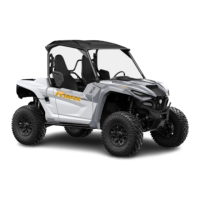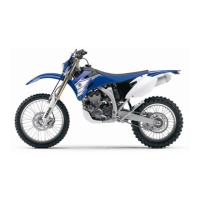Do you have a question about the Yamaha Wolverine X2 and is the answer not in the manual?
Read manual carefully for safety information.
Warning about chemical exposure from vehicle operation and service.
Owner's duty and understanding vehicle handling differences.
Requirements for driver and vehicle before operation.
Checks, load prep, and safe usage guidelines.
Safe driving, turning, and rollover avoidance.
Safety during tip/roll and carbon monoxide hazard.
Key safety advice before operating the vehicle.
Warnings on tire pressure, overloading, and vehicle certification.
Warnings regarding cargo bed and passenger safety.
Warnings about pinch points and improper off-road operation.
Explains various dashboard indicator lights.
Explains the main dashboard display components.
Limits vehicle top speed for controlled operation.
Critical safety and operational notices for winch use.
List of checks before operating the vehicle.
Procedures for checking brakes and fluid.
Warnings during refueling and fuel requirements.
Checks for handhold, steering, cables, and tires.
How to check and set tire pressure.
Guidelines for the initial 0-20 hours of operation.
Steps to start the vehicle's engine.
Shifting gears and operating in reverse.
How to select drive modes (2WD, 4WD, DIFF. LOCK).
Extra precautions for carrying loads or towing.
Guidelines for loading cargo and trailers, including limits.
Understanding vehicle's off-road handling and rollover risks.
Age, licensing, and responsibility requirements for drivers.
Passenger suitability and occupant protection system warnings.
Function of the vehicle's protective structure and body placement.
Why seat belts are crucial and general usage.
Detailed steps for correctly wearing seat belts.
Recommended safety gear for driver and passenger.
Familiarizing with drive modes and safe turning.
Safe acceleration, braking, and engine braking methods.
Operating on various terrains and loading limits.
Safe methods for navigating hills.
Safe downhill operation and rough terrain handling.
Operating on pavement, through water, and on slippery surfaces.
Benefits of periodic inspection, adjustment, and lubrication.
Maintenance schedule for emission control components.
Schedule for routine maintenance and lubrication.
When to change engine oil and replace the filter.
Procedure for checking the engine oil level.
Steps for draining and changing engine oil.
Combined procedure for oil and filter change.
Procedure to check transmission oil level.
Steps for draining and refilling transmission oil.
Procedure to check engine coolant level.
How to check and replenish brake fluid.
Brake fluid replacement and pedal free play checks.
Tips for diagnosing and resolving vehicle issues.
Charts for diagnosing starting and engine performance problems.
Details on warranty period, exclusions, and customer duties.
Read manual carefully for safety information.
Warning about chemical exposure from vehicle operation and service.
Owner's duty and understanding vehicle handling differences.
Requirements for driver and vehicle before operation.
Checks, load prep, and safe usage guidelines.
Safe driving, turning, and rollover avoidance.
Safety during tip/roll and carbon monoxide hazard.
Key safety advice before operating the vehicle.
Warnings on tire pressure, overloading, and vehicle certification.
Warnings regarding cargo bed and passenger safety.
Warnings about pinch points and improper off-road operation.
Explains various dashboard indicator lights.
Explains the main dashboard display components.
Limits vehicle top speed for controlled operation.
Critical safety and operational notices for winch use.
List of checks before operating the vehicle.
Procedures for checking brakes and fluid.
Warnings during refueling and fuel requirements.
Checks for handhold, steering, cables, and tires.
How to check and set tire pressure.
Guidelines for the initial 0-20 hours of operation.
Steps to start the vehicle's engine.
Shifting gears and operating in reverse.
How to select drive modes (2WD, 4WD, DIFF. LOCK).
Extra precautions for carrying loads or towing.
Guidelines for loading cargo and trailers, including limits.
Understanding vehicle's off-road handling and rollover risks.
Age, licensing, and responsibility requirements for drivers.
Passenger suitability and occupant protection system warnings.
Function of the vehicle's protective structure and body placement.
Why seat belts are crucial and general usage.
Detailed steps for correctly wearing seat belts.
Recommended safety gear for driver and passenger.
Familiarizing with drive modes and safe turning.
Safe acceleration, braking, and engine braking methods.
Operating on various terrains and loading limits.
Safe methods for navigating hills.
Safe downhill operation and rough terrain handling.
Operating on pavement, through water, and on slippery surfaces.
Benefits of periodic inspection, adjustment, and lubrication.
Maintenance schedule for emission control components.
Schedule for routine maintenance and lubrication.
When to change engine oil and replace the filter.
Procedure for checking the engine oil level.
Steps for draining and changing engine oil.
Combined procedure for oil and filter change.
Procedure to check transmission oil level.
Steps for draining and refilling transmission oil.
Procedure to check engine coolant level.
How to check and replenish brake fluid.
Brake fluid replacement and pedal free play checks.
Tips for diagnosing and resolving vehicle issues.
Charts for diagnosing starting and engine performance problems.
Details on warranty period, exclusions, and customer duties.
| Displacement | 847cc |
|---|---|
| Front Brakes | Dual hydraulic disc |
| Fuel System | Fuel injection |
| Front Suspension | Independent double wishbone |
| Rear Suspension | Independent double wishbone |
| Rear Brakes | Hydraulic disc |












